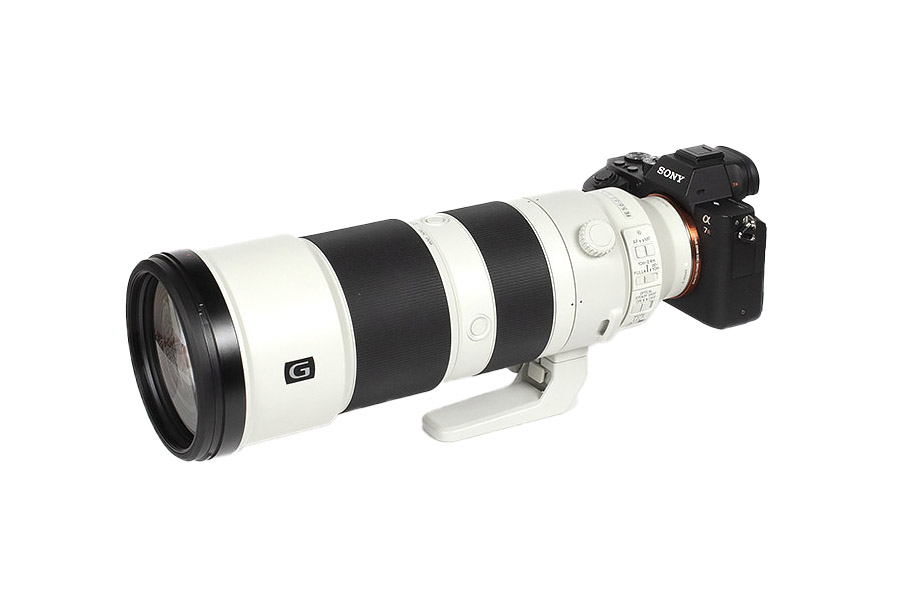by Klaus Schroiff, published September 2020
Introduction
Super-tele zoom lenses have been around for many years in the DSLR world. Especially Sigma and Tamron have a long history of providing several different and also interesting designs up to xx-600mm. Interestingly, the OEMs never dared to go there to date. However, such lenses were not available for mirrorless systems … that is until the release of the Sony FE 200-600mm f/5.6-6.3 G OSS. You may think that such a lens from Sony is pretty much unaffordable – and for many users, it’ll be out of reach indeed – but it’s actually a very reasonably priced lens at around 2000USD/EUR. In fact, it has a lower price tag than the Sony FE 100-400mm f/4-5.6 GM OSS which may be a little surprising. So what’s the catch?
When it comes to build-quality there is certainly none. On the contrary, unlike most other super-tele zoom lenses, the Sony lens does NOT extend when zooming. This also means is that it doesn’t suck in air and as such dust. It’s also formally dust- and moisture-resistant. Being a 600mm zoom lens means that it isn’t small to start with. And when mounting the deep lens hood makes it even more impressive. Yet again, in the grand scheme of things, it is reasonably compact although it can’t hide its weight of more than 2.2Kg. It’s just inevitable that big glass translates to high weight. Of course, this also means that the Sony lens features a dedicated tripod mount with a detachable foot. It’s not Arca-swiss compatible but there are some available from third-party suppliers if needed (e.g. Kirk or Wimberley).
Thanks to the internal zoom mechanism, zooming is a joy and doesn’t suffer from higher friction as in extending zoom lenses. The focus ring is very smooth as well. Typical for many Sony tele-lenses, it offers focus-stop buttons and the usual set of switches for AF, focus limiter, and image stabilizer.

We are still using an A7R II for testing and newer cameras, especially the A9 series, are certainly faster. However, even on this older camera we’d rate the AF speed as decent. If it’s possible you should probably use the focus limiter to avoid hunting throughout the focus range. Manual focusing (by wire) works nicely. We haven’t found any official figures regarding the efficiency of the image stabilizer (OS). We’d rate it in the 4 f-stop range which is pretty good for such a long lens. It has 3 different modes. Mode 1 is for allround purposes, mode 2 is for panning, and mode 3 is optimized for viewfinder stabilization over actual stabilization.
| Specifications | |
|---|---|
| Optical construction | 24 elements in 17 groups inc. 1x aspherical, 5x ED elements |
| Number of aperture blades | 11 (rounded) |
| min. focus distance | 2.4m (max magnification 1:5) |
| Dimensions | 111.5x318mm |
| Weight | 2115g |
| Filter size | 95mm |
| Hood | barrel-shaped, bayonet mount, supplied |
| Other features | focus hold button, dust- and moisture-resistant, 3-mode OSS, tripod mount, fluorine front element coating |
Distortion
The Sony FE 200-600mm f/5.6-6.3 G OSS has a somewhat unusual distortion characteristic. Very often, there’s a switch between barrel distortion at the short end and pincushion distortion at the long end of the zoom range but in this case, there are medium pincushion distortions around the 1.5% mark throughout the zoom range.
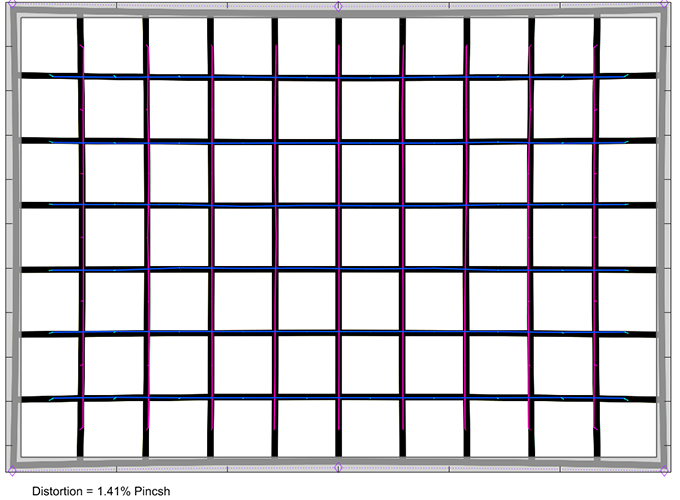
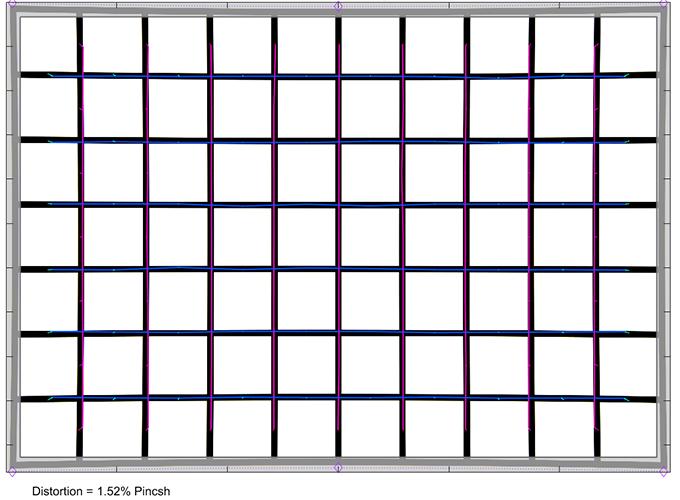

With activated image auto-correction, the distortions are perfectly corrected as you can see below.
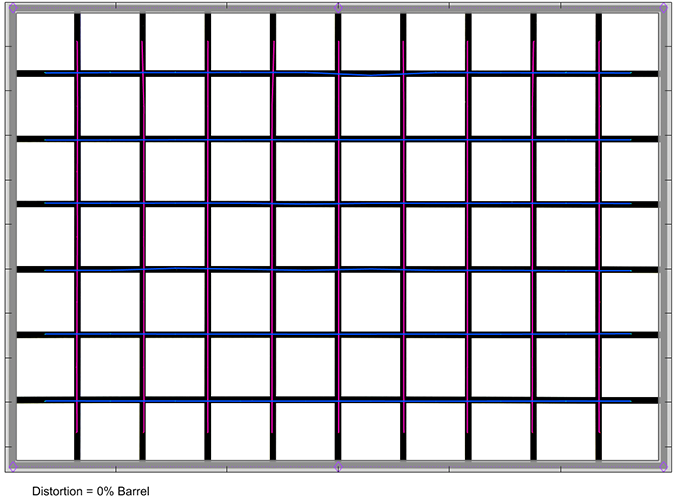
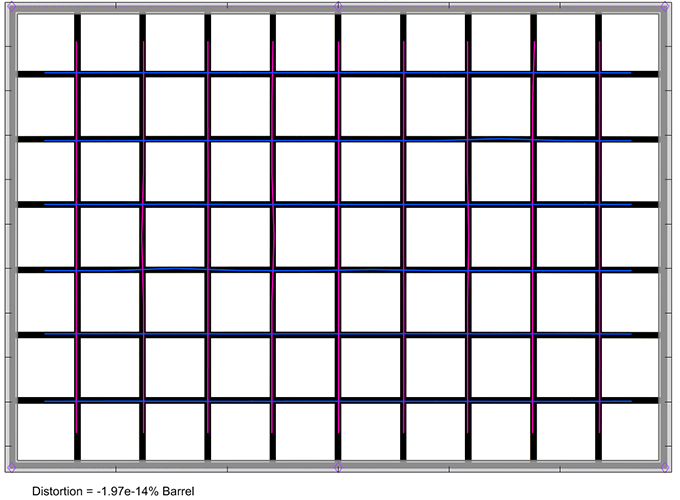
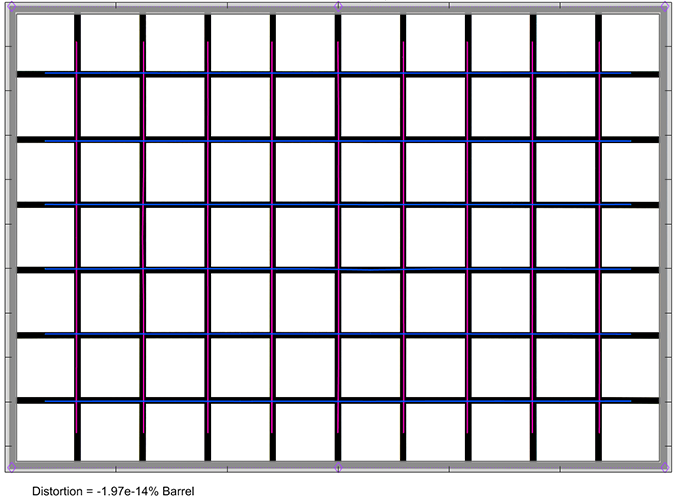
Vignetting
The RAW vignetting is about typical for a super tele zoom lens. At maximum aperture, the light falloff is visible without being extreme within the full format scope. The vignetting varies between 1.1EV (f-stops) at 200/400mm and 1.5EV at 600mm. Stopping down by 1 f-stop dissolves this mostly.
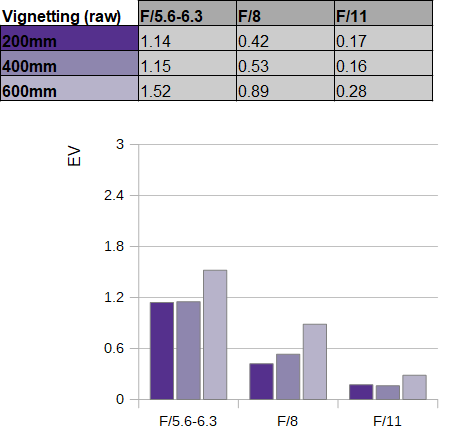
With activated image auto-correction, you won’t notice any significant light-falloff at any setting.
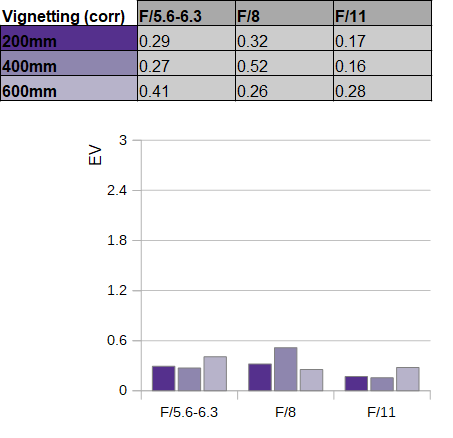
MTF (resolution)
The Sony FE 200-600mm f/5.6-6.3 G OSS shows a pretty impressive resolution characteristic for such a lens. At 200mm and 400mm, the broader center sharpness is great at f/5.6 (f/6.3) and the outer image region is easily on a very good level. Given the slow max. aperture and due to diffraction, it isn’t overly surprising that there’s no increase in quality anymore when stopping down. The situation is slightly different at 600mm. The center sharpness is still impressively high but the border and corner quality is reduced. Stopping down to f/8 or f/11 improves the outer image field but there isn’t too much in it and the center is limited by diffraction once again anyway.
The field curvature is low. The centering quality of the tested sample was Okay with a slight unevenness showing up at the long end.
Please note that the MTF results are not directly comparable across the different systems!
Below is a simplified summary of the formal findings. The chart shows line widths per picture height (LW/PH) which can be taken as a measure for sharpness. If you want to know more about the MTF50 figures you may check out the corresponding Imatest Explanations.

Chromatic Aberrations (CAs)
Lateral CAs (color shadows at the image borders) are somewhat more pronounced. The CAs peak with an average pixel width of ~2.1px at 200mm f/5.6. The issue is not quite as high at other settings but varies around 1.5px. Lateral CAs can be removed fairly easily via auto-correction so it’s not really a disturbance.

Bokeh
Super-tele zoom lenses tend to have a rather busy bokeh specifically with respect to the rendering of out of focus highlights. So how does the Sony FE 200-600mm f/5.6-6.3 G OSS manage in this respect?
It’s better than most actually. The bokeh highlights aren’t perfect but while there is a bit of outlining, it’s not extreme. The inner zone of the discs is just slightly uneven. The circular shape remains intact when stopping down to f/8 and even f/11. No less than 11 aperture blades surely help here.

The shape of the highlights tends to deteriorate towards the image borders – this is due to mechanical vignetting. However, the near-perfect zone is bigger than on most lenses and even the corner highlights aren’t overly unpleasant with their ellipsoid shape. As usual stopping down corrects the outer highlights and they are pretty much restored at f/11.

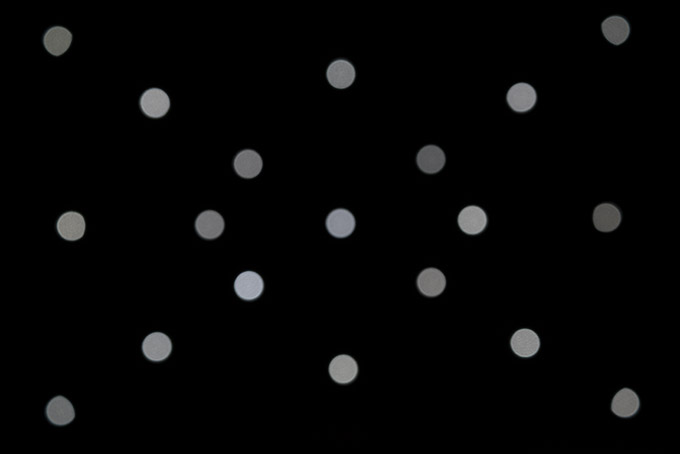

The general rendition in the focus transition zones is very smooth both in the background (shown to the left below) as well as in the foreground (to the right).

Sample Images
Competition
The Sony FE 200-600mm f/5.6-6.3 G OSS (shown to the left) is, as of the time of the writing, the longest zoom lens available for Sony FE cameras. If you don’t require a 600mm setting, there are currently two xx-400mm options at least – neither of which we have tested at this stage. The most prominent one if the Sony FE 100-400mm f/4.5-5.6 GM OSS. It is a GM lens thus rated somewhat higher by Sony and it’s also more expensive. However, it seems unlikely that it is actually better in the overlapping range but it does add some flexibility at the short end. The FE 100-400mm f/4.5-5.6 GM OSS also accepts converters (as does the FE 200-600mm) and adding the 1.4x transforms it to a 140-560mm f/7.1-8 but don’t expect better results than on the “native” 600mm lens. The other option is the new Sigma 100-400mm f/5-6.3 DG DN OS – and it’s substantially more affordable. Yet, the Sigma seems to be capable of delivering very sharp results. It is worth pointing out that both 100-400mm lenses extend when zooming towards the long end and at 400mm, they are actually not much shorter than the FE 200-600mm (which doesn’t extend).

Image courtesy of camerasize.com
The Sony FE 200-600mm f/5.6-6.3 G OSS is not a perfect lens but it is no less than a steal for the money and it alone may be a reason for buying into the Sony system - if you are really into such long tele lenses. The Sony lens is, unsurprisingly, very sharp in the lower to mid parts of its zoom range. At 600mm, the corner quality suffers somewhat whereas the center quality remains impressively high. Most photographers won't probably ever notice this but there are limits when it comes to astrophotography here. Image distortions are present but can be handled via image auto-correction activated. This will also take care of the lateral CAs which are on the high side. The native vignetting is typical for such a lens. A positive surprise is the quality of the bokeh which is (substantially) better than most lenses in this class although prime lenses are better still.
The build quality of the Sony lens is superb thanks to a tightly assembled, metal body. Sony also didn't forget to implement dust- and moisture-resistant seals. We can't emphasize enough that it is unusual for a sanely priced super-tele zoom lens to have a constant physical size. Other than the obvious advantage regarding air movement within the lens, it also allows for a much smoother (easier) zoom experience compared to the usual "air pumps". The AF is pretty fast and noiseless. We were also impressed by the real-world efficiency of the image stabilizer.
The Sony FE 200-600mm f/5.6-6.3 G OSS is a big and heavy lens and mounted to a small Sony camera, the setup can feel a bit unbalanced so adding a vertical grip may be a sensible investment for improving handling. Regarding the sum of its qualities combined with the very reasonable price tag, the verdict can only be - highly recommended!
-
Optical Quality
-
Build Quality
-
Price / Performance


